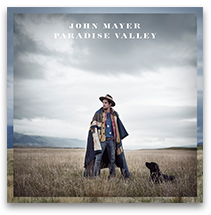Mayer’s new album, a taste of ‘Paradise’

Mayer fans rejoiced with the release of ‘Paradise Valley’
September 4, 2013
The blues and pop communities both rejoiced as John Mayer made his return with his newest album, “Paradise Valley.” Mayer, who had plenty of recovery time after developing a granuloma, a benign mass of tissue, on his vocal chord, bounced back with both a brand new album, a fresh tour and an apology for his actions after suddenly canceling his tour last March. With his spare time, Mayer began composing “Paradise Valley.” Fusing western slide guitar, poppy melody and classic southern blues with his classic snappy yet smooth guitar riffing, the album is a breath of fresh air for Mayer and music fans alike.
With all of these influences bleeding masterfully into one coherent, metaphorical album, it’s obvious that Mayer, as he is aging, is returning to his earliest role models for inspiration. This includes B.B. King, Jimi Hendrix, Eric Clapton and perhaps Stevie Ray Vaughan whose influence is seen most prominently in Mayer’s latest work. While many artists confuse inspiration with musical plagiarism, Mayer is able to convey the sounds of his idols without sounding unoriginal. The album plays smoothly, seamlessly and with little pretension. Whether a John Mayer fan or not, music lovers will find something that speaks to them somewhere in the album.
The album starts off with his single “Wildfire,” which sports a reverb-inundated recurring riff throughout the course of the song. A video of Mayer was released a month before the single, playing the riff repeatedly with a huge grin, showing how catchy and alluring the guitar part could be. The song epitomizes Mayer’s mastery of dynamics, going from the signature riff to simple vocals and drums for the chorus. The listener will encounter a slew of different sounds including the country driven songs such as “Dear Marie,” which also appeals to the current indie trend of the “oh” chants, “Waiting on the Day,” “You’re No One ‘Til Someone Lets You Down”and “Badge and Gun.” The other songs range from duets and cameos, such as Katy Perry, Mayer’s girlfriend, on “Who Will You Love,”which sounds similar to brass-fueled ballads from the 1960s, as well as Frank Ocean’s performance on the short reprise of “Wildfire.” More rock-fueled listeners will be pleased with “I Will Be Found Lost at Sea,” a song filled with hurt, hope and recovery in the same style as the Beatles’ “Let It Be,” as well as Mayer’s cover of the Lynyrd Skynyrd classic, “Call Me the Breeze.”
“Paradise Valley” seems to be one 40-minute metaphor that will enlighten the listener until the end of the album. “Wildfire” starts the album with the lyrics “cause a little bit of summer’s what the whole year’s all about” and “On the Way Home” caps it off with the verse “the summer’s over, this time is closing.” By the end of the album, Mayer has put into musical terms what every student finds themselves musing by September: “where the did summer go?” He sums up any emotions of a summertime young adult, ranging from relaxation, to heartbreak, to the realization of the end of summer and the beginning of adulthood. Wrapping the album up at a modest 40 minutes with 11 songs, Mayer shows quite literally how summer can feel like a mere hour of someone’s life. The album is available on iTunes and can also be streamed for free on Spotify.







